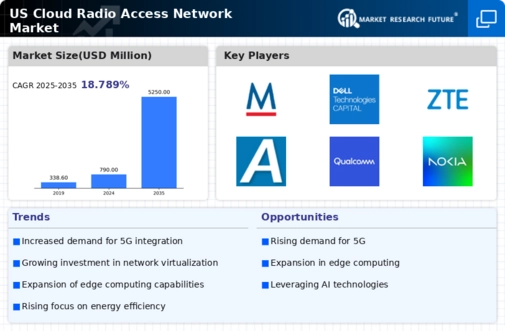Increased Focus on Network Flexibility
Flexibility in network architecture is becoming a critical driver for the cloud radio-access-network market. As organizations strive to adapt to rapidly changing technological landscapes, the ability to scale and modify network resources on demand is essential. The US telecommunications sector is witnessing a shift towards more agile network solutions, allowing operators to respond swiftly to market changes and customer needs. According to industry reports, nearly 70% of telecom operators in the US are investing in cloud-based solutions to enhance their operational flexibility. This trend indicates a growing recognition of the advantages offered by cloud radio-access-network technologies, which facilitate dynamic resource allocation and improved service delivery. As businesses increasingly prioritize flexibility, the cloud radio-access-network market is likely to benefit from heightened investments and innovations aimed at creating adaptable network infrastructures.
Rising Investments in 5G Infrastructure
The cloud radio-access-network market is poised for growth due to the rising investments in 5G infrastructure across the US. Telecommunications companies are actively deploying 5G networks to meet the escalating demand for faster and more reliable mobile connectivity. The National Telecommunications and Information Administration (NTIA) has highlighted that investments in 5G infrastructure are expected to exceed $275 billion by 2025, underscoring the urgency for advanced network solutions. Cloud radio-access-network technologies play a pivotal role in enabling the efficient deployment and management of 5G networks, offering enhanced capacity and reduced latency. As the rollout of 5G continues, the cloud radio-access-network market is likely to experience significant growth, driven by the need for innovative solutions that support the next generation of mobile communication.
Growing Demand for High-Speed Connectivity
The cloud radio-access-network market is experiencing a surge in demand for high-speed connectivity, driven by the increasing reliance on data-intensive applications. As businesses and consumers alike seek faster internet speeds, the need for advanced network solutions becomes paramount. In the US, the Federal Communications Commission (FCC) has reported that broadband adoption has reached approximately 90% of households, indicating a robust market for enhanced connectivity solutions. This trend is likely to propel investments in cloud radio-access-network technologies, as they offer scalable and efficient solutions to meet the growing bandwidth requirements. Furthermore, the shift towards remote work and online services has intensified the need for reliable and high-speed internet access, further fueling the growth of the cloud radio-access-network market. The convergence of these factors suggests a promising outlook for the industry as it adapts to the evolving demands of connectivity.
Growing Need for Enhanced Network Security
As cyber threats continue to evolve, the cloud radio-access-network market is witnessing a growing emphasis on enhanced network security measures. Organizations are increasingly aware of the vulnerabilities associated with cloud-based solutions, prompting them to invest in robust security frameworks. The US Cybersecurity and Infrastructure Security Agency (CISA) has reported a rise in cyber incidents, highlighting the necessity for secure network architectures. Consequently, telecom operators are prioritizing the integration of advanced security protocols within their cloud radio-access-network solutions. This trend indicates a proactive approach to safeguarding sensitive data and maintaining customer trust. As the demand for secure network environments escalates, the cloud radio-access-network market is likely to benefit from innovations aimed at fortifying security measures, ensuring that operators can effectively mitigate risks while delivering reliable services.
Emphasis on Cost Efficiency and Operational Savings
Cost efficiency remains a primary concern for organizations, driving the adoption of cloud radio-access-network technologies. Businesses are increasingly seeking ways to reduce operational expenses while maintaining high-quality service delivery. The cloud radio-access-network market offers solutions that enable telecom operators to optimize their infrastructure and reduce capital expenditures. Reports indicate that companies can achieve operational savings of up to 30% by transitioning to cloud-based network solutions. This financial incentive is particularly appealing in the competitive US telecommunications landscape, where cost management is crucial for sustaining profitability. As organizations recognize the potential for significant savings, the cloud radio-access-network market is likely to see accelerated growth, as more players seek to leverage these cost-effective technologies to enhance their service offerings.

















Leave a Comment